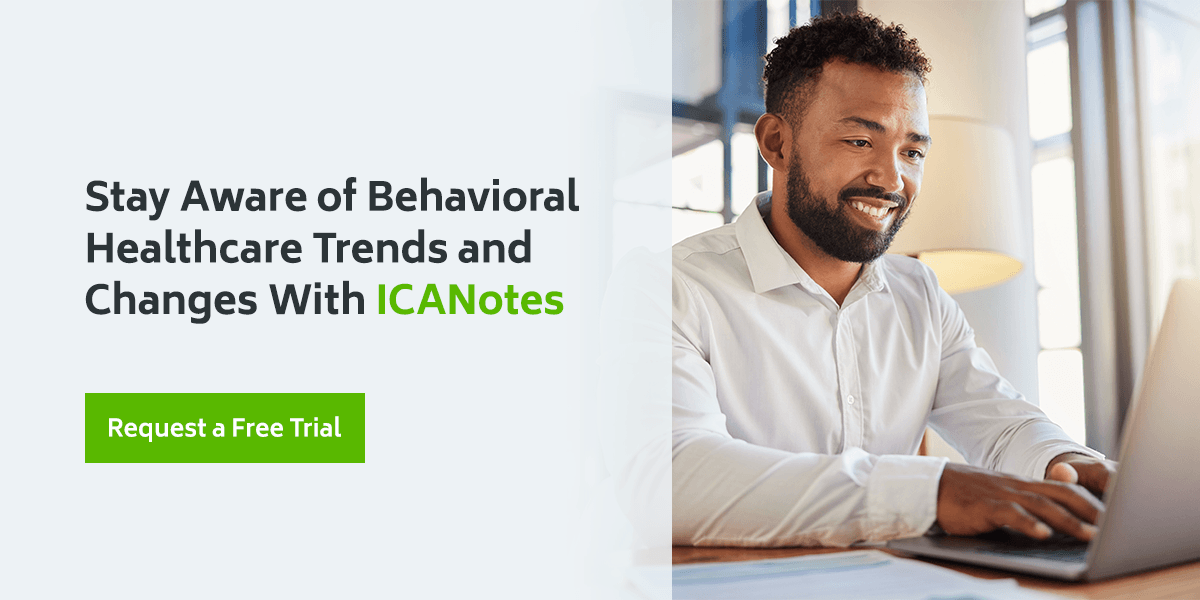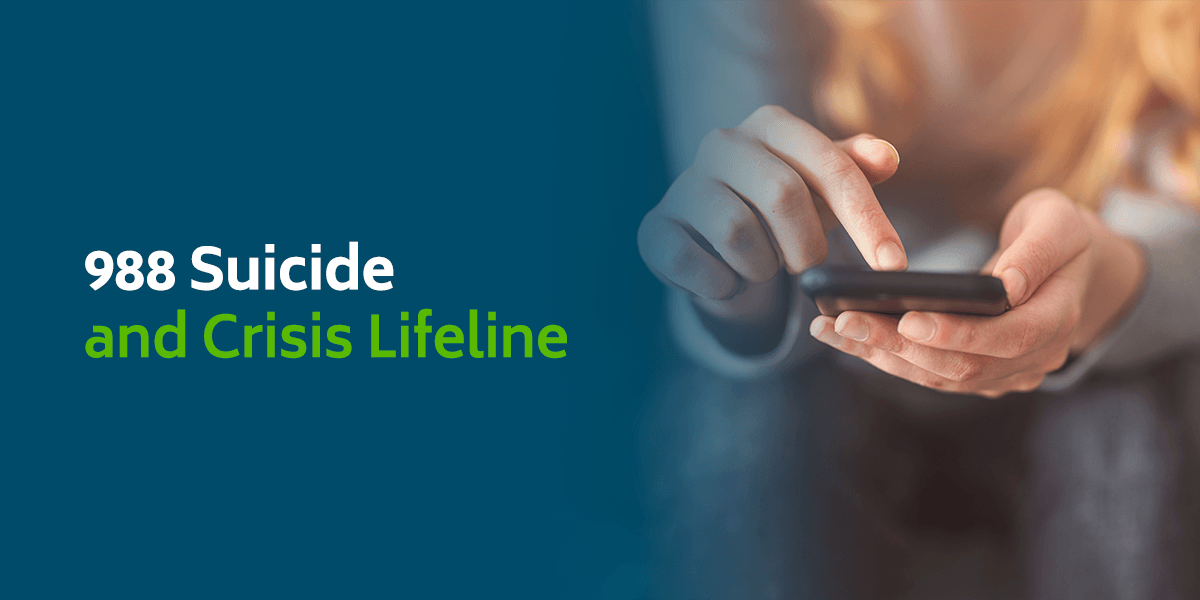
988 Suicide and Crisis Lifeline
In 2020, a death by suicide occurred every 11 minutes in the United States. In 2021, this average increased by 4%, amounting to 47,646 deaths in total. With this increase, it's natural to assume many mental and behavioral health professionals may be concerned about the accessibility of suicide prevention for mental health crises. Fortunately, the Federal Communication Commission (FCC) has created a new number to reach the suicide prevention hotline.
As we're taught from childhood to dial 911 for emergency services, the 988 crisis line number will be used to access mental health emergency services. Let's explore everything you need to know about the new 988 suicide and crisis lifeline and how it impacts your profession.
What Is the New Suicide and Crisis Hotline?
The new suicide lifeline number change has occurred primarily because the previous 11-digit number — 1-800-273-8255 or (1-800-273-TALK) — was thought by many to be too difficult for people to remember while in an emergency. When in a state of crisis, such as having suicidal thoughts, not being able to remember the emergency hotline can make all the difference when it comes to saving someone's life. If the number is too difficult to recall during emotional distress, it can prevent people from contacting the help they need.
The FCC first reported this potential nationwide number change to Congress in 2019. In 2020, Congress officially designated 988 to operate through the previous National Suicide Prevention Lifeline. This was the first step toward transforming crisis and mental health care in America. By July 2022, the 988 number was fully activated across the United States.
What Is the Purpose of the Hotline?
The goal of switching to this three-digit code is to increase accessibility for those looking for help during mental health emergencies. Just as calling 911 is an instinct if you see a car crash or smell a fire, 988 will soon become the instinctive number to receive other life-saving help. This number also has a crisis text line, so people can call, text or chat online.
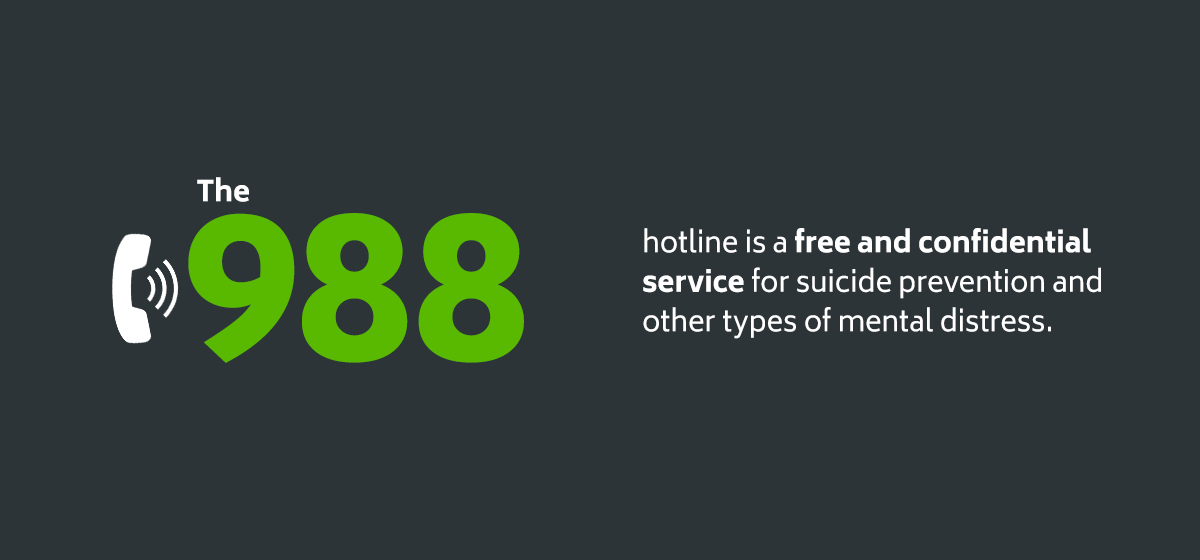
These different options make it easier for people who may have certain disabilities to contact help immediately. When people call 988, they will be connected directly to a 24/7 mental health crisis call center with trained professionals equipped to handle mental health situations, including life-threatening emergencies. These counselors will listen, provide support and connect people to various resources if necessary.
The national suicide hotline consists of a network of over 200 crisis centers that all engage in a variety of initiatives to improve mental health crisis services and suicide prevention techniques. Studies show that callers feel less depressed, less suicidal and more hopeful after calling the Lifeline number and speaking with a trained counselor.
This new number change simply aims to make this connection even faster and easier. While the nation has switched to 988 as the official Lifeline phone number, the previous number, 1-800-273-8255, will always be available to those experiencing suicidal thoughts or emotional distress.
Benefits of the New 988 Suicide Lifeline Number
Many people who do not know the suicide hotline number may instinctively call 911 when in distress or experiencing another type of behavioral health emergency. While this is sometimes effective, particularly in instances when a person is threatening violence to themselves or others, it typically means that law enforcement services will be involved, who may not be as effectively trained in supporting those with mental illness or developmental disabilities as those trained for mental health crises.
Additionally, placing a call to 911 may not always result in a person receiving resources for further assistance after they're stabilized, which can result in them ending up in the same emotional state down the road. Finally, those who call 911 when experiencing a mental health crisis, but not necessarily suicidal thoughts or ideation, may prevent life-threatening emergencies from being dealt with if the hotline is experiencing high-volume calls.
Due to these reasons, 988 serves as the primary line and behavioral health emergency response system to expand community access to mental health services. Here are some additional benefits of the new 988 Lifeline number:
- Increased contacts through calls, chat and text allow professionals to help more people in mental health crises.
- Those in crisis can access trained, qualified professionals for support.
- More accessibility means less burden on emergency medical services and law enforcement.
- The attention to the new 988 number can prompt states to ensure adequate funding of crisis and stabilization services.
- Those who are not in crisis can still use the 988 number on behalf of someone else, such as a loved one, and receive helpful information.
- The 988 hotline can be used for many types of mental distress, such as substance abuse.
- Those who call the Lifeline can access tools and resources to prevent future crises.
Suicidal Ideation Assessment Tools
These tools aim to help clinicians effectively assess and document suicidal ideation during patient encounters. With these tools, you will be able to better support your patients and reduce the risk of suicide.
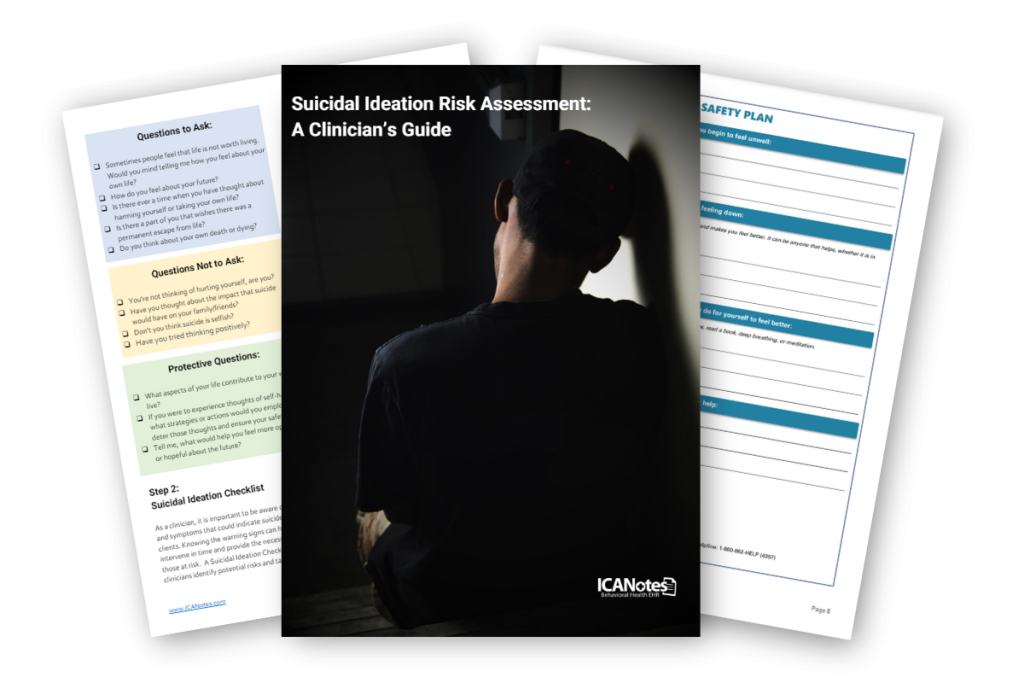
How the Crisis Lifeline Is Impacting Behavioral Healthcare Providers
The expansion of mental health services is certainly beneficial to you as a mental or behavioral health provider. While you likely see between 10 and 30 patients a week, you may feel a sense of guilt that you are not available to your clients 24/7. Many therapists and counselors nowadays are struggling with burnout and stress as a result of heavy caseloads and underfunding. Some counselors may even feel pressured to take on more clients due to the rise in mental health conditions and substance abuse disorders in the last few years.
If you call into this category, you may feel a sense of support from the new 988 Lifeline number. This hotline is not just for people who are feeling suicidal — it aims to help those in many circumstances of mental distress, such as panic and anxiety attacks or substance abuse.
Greater Access to Mental Health Services Means Less Burden on Providers
The increased and free accessibility to mental health services can reduce the burden on behavioral healthcare providers who may already be struggling to handle their workload as it is. Research supports this point by highlighting an association between greater availability of mental health care and lower rates of suicide. One study found that suicide is more common in communities facing limited access to mental health care.
With the new 988 number, anyone in the nation can instantly access a trained professional equipped with the tools and resources to stabilize their condition and help them access long-term treatment. Many of those who used the suicide prevention number and received follow-up resources and interventions felt hopeful and cared about because the calls kept them safe and, ultimately, stopped them from going through with suicide.
This means that the 988 acts as an ideal resource for those experiencing mental health distress without having to book and wait for an appointment with a therapist.
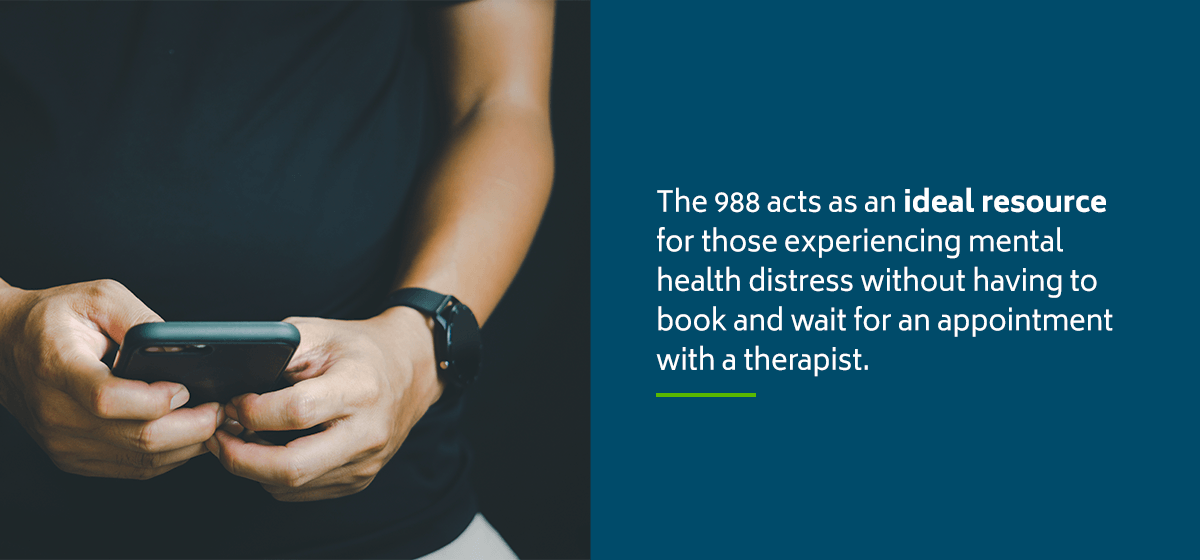
FAQs About the New Hotline Number
Let's look at some common questions you, your patients and those in crisis may have about the new Lifeline number.
1. Does the Suicide Hotline Call the Police?
LThe answer to this question varies. Professionals that work on the hotline have very specific, detailed protocols. In some cases, it is necessary and appropriate to contact 911 and have emergency services involved, such as if a caller cannot be stabilized over the phone or appears to have access to a weapon that could hurt themselves or others.
Responders on the 988 Lifeline typically use the Columbia Suicide Severity Rating Scale (C-SSRS), a questionnaire that helps them assess suicide risk. If it appears there is an imminent risk to the caller's life that cannot be reduced, the crisis counselor may connect to 911 services.
2. Can I Call the Suicide Hotline Just to Talk?
Yes! The primary goal of 988 is to help those in any sort of mental health or substance abuse crisis. 988 provides easier access to related resources, whereas the main focus of 911 is to access emergency medical, fire or police services. Since 911 is reserved for emergencies only, callers who feel distressed but not suicidal may feel they can't reach out to the hotline if it's not life-threatening. However, with the 988 Lifeline, anyone can call.
Though the majority of calls are from people considering suicide, many loved ones and concerned family members also reach out to the 988 hotline to learn how it works. Therapists, counselors and other mental health providers can also use 988 to look for assistance in determining a patient or client's suicide risk.
3. When Should I Call the Suicide Hotline?
If you're experiencing suicidal thoughts or ideation, call 988 at any time. The hotline is available 24/7 with supportive, caring professionals who can help you if you're struggling and are unable to access other mental health services in your community. You can also call the hotline if you're experiencing substance abuse issues or other mental health conditions, such as anxiety or depression.
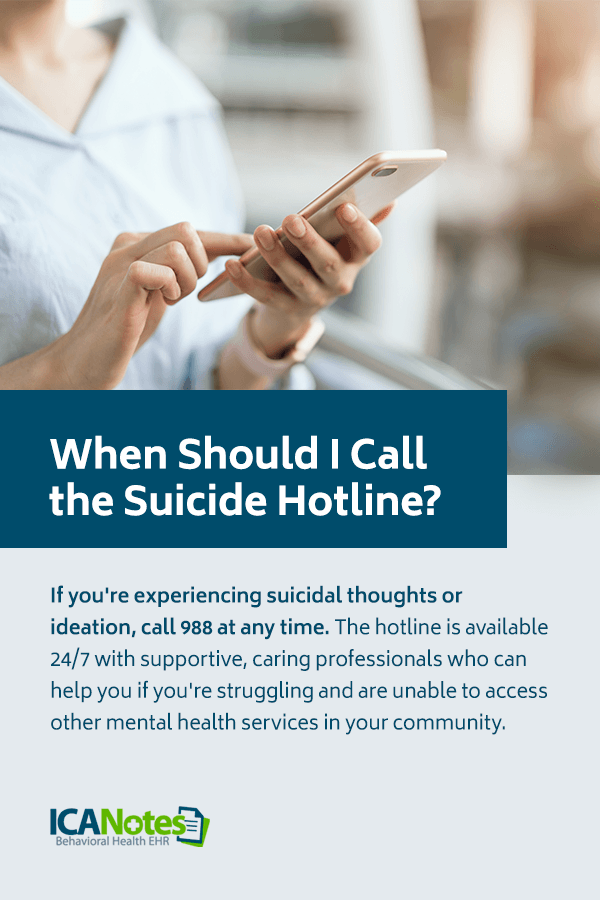
4. Do Suicide Hotlines Work?
Yes. There is plenty of available data that supports the effectiveness of suicide and mental health crisis hotlines. For example, over 400,000 people called the 988 Lifeline in both October and November of 2022. Online chats and text contacts also significantly increased over the month-long period, and the average speed to answer across all contacts was 36 seconds.
Approximately 98% of the people who call, chat or text the 988 Lifeline receive the support they need during a mental health crisis and do not require additional services. This is because Lifeline crisis counselors are specifically trained to reduce the intensity of a distressing situation and connect them to the appropriate resources to support their well-being.
5. Will 988 Replace the Old Lifeline?
The 988 will not replace the old 1-800 number, as that number is still active. However, 988 is a much easier number to remember and helps increase access to a large network of crisis call centers. the 1-800 suicide hotline number will never go away.
6. When Will 988 Be Activated Across the Nation?
The 988 hotline is currently active and available nationwide in multiple languages and has options for call, chat and text.
7. How Is 988 Being Funded?
Congress and the FCC have laid the foundation for the 988 number, and the Department of Health and Human Services (HHS) has also generated funding through the American Rescue Plan. States can individually enact telecommunication fees to support the 988 workforce and operations.
8. What Happens When Someone Contacts 988?
When an individual contact 988 by phone, text or chat, they will immediately be connected to a trained crisis counselor at a local call center based on their area code. The counselor will stay on the line with the caller as long as needed to de-escalate their emotional or mental distress. If necessary, Lifeline counselors will dispatch a mobile crisis team to the caller's location.
If the local crisis center is unable to take the call due to high volumes of callers, the individual will be automatically routed to a national backup crisis center. The Lifeline number provides both English and Spanish for calls and offers translation services in over 250 additional languages.
9. Who Can Contact 988?
Anyone can contact 988. This service is completely free to people of all ages. While the main goal of the Lifeline is to help those dealing with suicidal thoughts, mental health or substance abuse crises and emotional distress, loved ones may also call this number. For instance, if you know of a friend or family member who is experiencing a crisis, you can call 988 and talk with a counselor about how to help that person and determine if 911 emergency services are needed.
10. Can Behavioral Health Professionals Share 988 With Patients?
Yes. As a counselor, therapist, psychiatrist or any other behavioral health professional, it's important to share the new 988 Lifeline number with your patients. If you have clients who suffer from suicidal thoughts or depression, they can benefit from having this number on hand when they are not able to contact you outside of business hours in the event of a crisis. Additionally, sharing this number with your patients can give them free access to help and resources instead of calling 911 or going to an emergency room.
Because the 988 Lifeline is free, confidential and runs 24/7, 365 days a year, your patients may feel a sense of relief that they will always have someone to talk to if they are in a state of crisis. As a provider, it's also necessary to educate your patients about the 988 Lifeline due to many concerns and worries they may have about involuntary hospitalizations or unwanted law enforcement visits.
According to the American Psychological Association (APA), while some 988 calls may route to 911 in order to save someone's life, these actions are rare. About 8 out of 10 calls to 988 are resolved over the phone. Simply notifying your clients of this new nationwide number can advance suicide prevention and spread awareness about life-saving crisis centers.
Stay Aware of Behavioral Healthcare Trends and Changes With ICANotes
As a behavioral health professional, you know how important it is to stay up to date with the latest news in mental health services and information. However, if you're spending too much time on documentation and administrative tasks, it's easy to see how you may fall behind.
With ICANotes, you can access a behavioral health electronic health record (EHR) that takes care of your most important counseling needs so you can spend more time with your patients and promote the use of the 988 hotline when it's needed. Whether you want to reduce your note-writing time, speed up billing processes or enhance your telehealth support, we have everything you need.
We invite you to visit our mental health archive to learn more about this topic or contact us for a live demo of our software.

